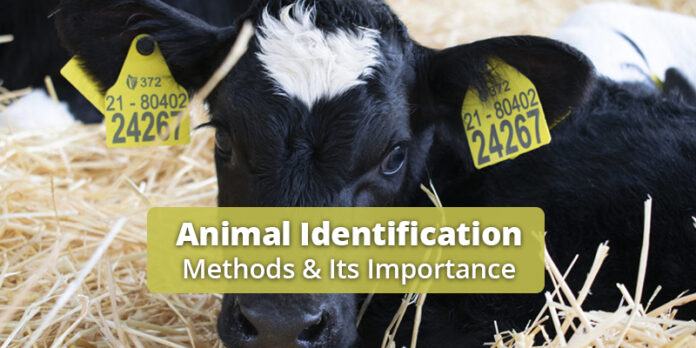PROCEDURE FOR APPLICATION OF EAR TAGS
Tagging livestock is an important part of animal identification but must be done properly to keep the animal from losing its tag or getting an infection. To properly tag an animal, one must understand the importance of placement, identification, precautions, and use of the tag applicator.
Equipments Required: Ear tag and an Applicator Procedure :
- Securing the animal:
Properly secure the animal to limit the animal’s head movement during the tagging process. Limiting head movement prevents improper tagging or injury to the animal or human doing the tagging.
- Disinfection:
Proper hygiene is necessary to prevent infections. Use rubbing alcohol or disinfectant to clean the applicator as well as the tagging site in the ear.
- Tags:
The ear tag composed of two parts (Male + Female). The male portion of the tag is the stud piece/ visual panel. The button, or female portion of the tag have a closed head.
Figure: Male (Stud) and Female parts (button) of Ear tag
- The applicator :
Place each half of the tag onto the applicator. The stud must be completely onto the applicator pin and the panel/button portion must be under the opposite clip. Make sure the applicator pin is not bent or broken. Make sure the applicator is aligned before tagging the animal by closing the applicator to the point where the two halves meet; the stud should be centered with the hole. Make sure the applicator is aligned before tagging the animal by closing the applicator to the point where the two halves meet; the stud should be centered with the hole.
- Check the alignment of the applicator jaw:
Before you get to tagging, give your applicator a practice run. Squeeze the handles of the device together slowly so that the jaw closes to the point just before the two tag pieces meet (Figure). The stud should be perfectly centered with the hole in the backing piece.
Figure : Proper tag alignment before tagging
If the hole and stud are out of alignment, it may be necessary to remove and reload them.
Be careful not to close the jaw completely, or you’ll waste a tag.
- Tagging Site:
Identify the tagging site on the ear. Tags should be placed in the middle third of the ear between the upper and lower ribs i.e the location should be between the rises in auricular cartilage or the ribs. Tags placed too far outside the recommended area are
prone to snagging and getting ripped out, while tags too far inside the animal’s ear could cause pinching or necrosis. Place the male part of the tag on to the back of the ear with the female to the inner ear. The tip of the male part should be in the centre of the ear,
between the ridges of cartilage avoiding any obvious veins. Squeeze the applicator firmly together.
Figure . Proper tag placement location
If a tag is placed too far towards the inside of the ear it will fit tightly due to the presence of thicker cartilage. This may also cause necrosis, the death of cells in the tissue, or sloughing tissue which is the shedding of dead cells. Tags placed too far to the outside of the ear have the possibility to be snagged or ripped out. Proper tag placement is also important to reduce the risk of infection.
If placed incorrectly, a tag could potentially cause problems, therefore location is very important. The ideal location to place an ear tag is in the middle one-third of the ear between the upper and lower ribs. Numbers and bar code should be covering full size of the female tag and leaving 2 mm margin on all sides. The location should be between the rises in auricular cartilage or the ribs. It is important to apply the tag with the male portion, of the tag on the outside back of the ear with the button, female portion, of the tag on the inside of the ear.
Figure. Correct and incorrect tagging sites
- Watch for infection:
Once the animal has been tagged, monitor the tagged area for infection. Apply hydrogen peroxide directly to the ear tag puncture for five to seven days to prevent infections. If a serious infection occurs, consult your veterinarian.

TECHNICAL SPECIFICATIONS OF EARTAG EARTAG APPLICATOR


